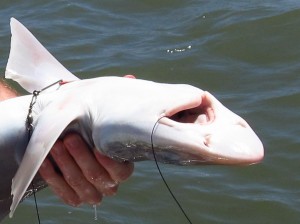When you work on the water long enough, you encounter some unique situations. Whether it’s getting stranded during field work, surviving massive seasickness, having your equipment attacked by hostile sea life, or just seeing something unusual, these anecdotes are an important part of what makes marine science fun (sometimes moreso in hindsight). That’s why I’m creating a new category for posts here called “Fish Tales,” where we can share these stories. To start with, here is a literal fishing story.
While I was down in Morehead City for some field work (post on that coming soon), I got the chance to do a little fishing with fellow Southern Fried writers Andrew and Amy and check on potential sites for shark sampling this summer. I’d wanted to test out a new fishing rod set up for sharks and large fish, and had rigged up a wire leader with a size 12/0 circle hook. While casting, it became very clear that I hadn’t properly attached the leader to the swivel when I pulled back an empty swivel where the leader had been. Frustrating, but I’m practically required to lose gear every time I fish, so I rigged up a second wire leader with a J-hook that was on hand.
Circle hooks are used by recreational and commercial hook-and-line fisheries (and many longliners) to reduce hooking mortality in large fishes, sharks, and bycatch animals like sea turtles. The idea is that the hook more or less works by itself without being set like a J-hook. The shape of the hook prevents swallowing and encourages hooking in the corner of the mouth, where it’s less likely to do serious damage.
Finally, something took the bait. That something turned out to be a decent-sized male smooth dogfish, foul-hooked. Interestingly, there was a wire leader coming out of its mouth. A wire leader that looked an awful lot like the one I had lost.

With no line to pull against it, the smooth dogfish had no problem gulping down the entire hook and about half the wire leader. The leader disappeared down into the esophagus, way too deep to have any hope of grabbing it with the de-hooker. We were sure we had gut-hooked this poor animal.
After replacing the swivel and putting the old wire leader and hook back on, we kept fishing. Two cownose rays (one on the bait we pulled back out of the smooth dogfish) and a juvenile sandbar shark made appearances. The catch alone would make this a good day of fishing, but this is honestly the first time I’ve had a fish return lost gear.
Here are some other fishing pics.
More photos from the trip can be found here. All in all, a good trip and a decent fish tale. Anyone else have any good stories?
Very cool. I’m gonna start using them.
9/0. Circle hook thin wire no offset will leave a smaller hole from the thin shank and go in much easier and you can use gloves take wraps and pull the hook out if its stuck because it will straighten out.
I use them on Makos up to 200#